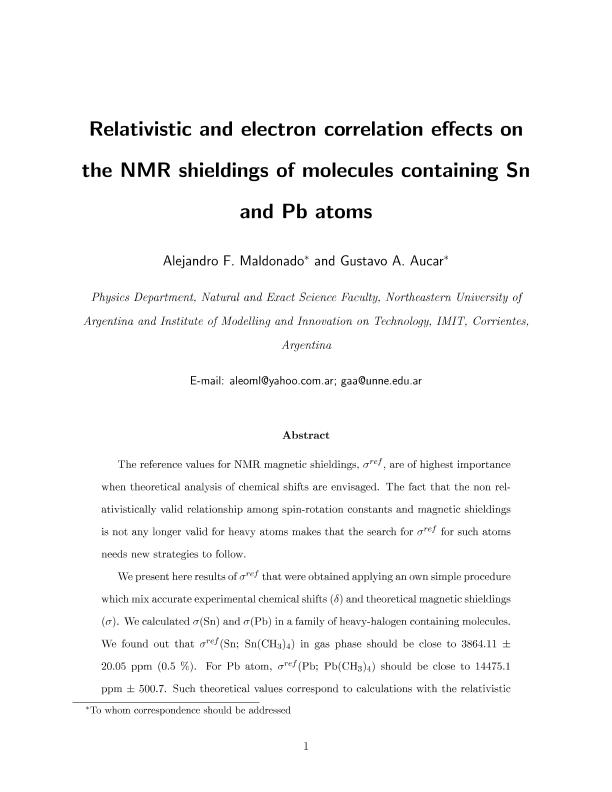Artículo
Relativistic and electron-correlation effects on the nuclear magnetic resonance shieldings of molecules containing tin and lead atoms
Fecha de publicación:
08/2014
Editorial:
American Chemical Society
Revista:
Journal Of Physical Chemistry A
ISSN:
1089-5639
Idioma:
Inglés
Tipo de recurso:
Artículo publicado
Clasificación temática:
Resumen
The reference values for NMR magnetic shieldings, σ ref , are of the highest importance when theoretical analysis of chemical shifts are envisaged. The fact that the nonrelativistically valid relationship among spin-rotation constants and magnetic shieldings is not any longer valid for heavy atoms requires that the search for σ ref for such atoms needs new strategies to follow. We present here results of σ ref that were obtained by applying our own simple procedure which mixes accurate experimental chemical shifts (δ) and theoretical magnetic shieldings (σ). We calculated σ(Sn) and σ(Pb) in a family of heavy-halogen-containing molecules. We found out that σ ref [Sn;Sn(CH 3 ) 4 ] in gas phase should be close to 3864.11 ± 20.05 ppm (0.5%). For Pb atom, σ ref [Pb;Pb(CH 3 ) 4 ] should be close to 14475.1 ± 500.7 ppm . Such theoretical values correspond to calculations with the relativistic polarization propagator method, RelPPA, at the RPA level of approach. They are closer to experimental values as compared to those obtained applying few different functionals such as PBE0, B3LYP, BLYP, BP86, KT2, and KT3 of the density functional theory, DFT. We studied tin and lead shieldings of the XY 4−n Z n (X = Sn, Pb; Y, Z = H, F, Cl, Br, I) and PbH 4−n I n (n = 0, 1, 2, 3, 4) family of compounds with four-component functionals as implemented in the DIRAC code. For these systems results of calculations with RelPPA-RPA are more reliable than DFT ones. We argue about why those DFT functionals must be modified in order to obtain more accurate results of NMR magnetic shieldings within the relativistic regime: first, there is a dependence among both electron-correlation and relativistic effects that should be introduced in some way in the functionals; and second, the DIRAC code uses standard nonrelativistic functionals and the functionals B3LYP and PBE0 were parametrized only with data taken from light elements. It can explain why they are not able to properly introduce relativistic effects on nuclear magnetic shieldings. We finally show that in the analysis of magnetic shieldings for the family of compounds mentioned above, one must consider the newest and so-called heavy-atom effect on vicinal heavy atoms, HAVHA. Such effects are among the most important relativistic effects in these kind of compounds.
Archivos asociados
Licencia
Identificadores
Colecciones
Articulos(CCT - NORDESTE)
Articulos de CTRO.CIENTIFICO TECNOL.CONICET - NORDESTE
Articulos de CTRO.CIENTIFICO TECNOL.CONICET - NORDESTE
Articulos(IMIT)
Articulos de INST.DE MODELADO E INNOVACION TECNOLOGICA
Articulos de INST.DE MODELADO E INNOVACION TECNOLOGICA
Citación
Maldonado, Alejandro Fabian; Aucar, Gustavo Adolfo; Relativistic and electron-correlation effects on the nuclear magnetic resonance shieldings of molecules containing tin and lead atoms; American Chemical Society; Journal Of Physical Chemistry A; 118; 36; 8-2014; 7863-7875
Compartir
Altmétricas




